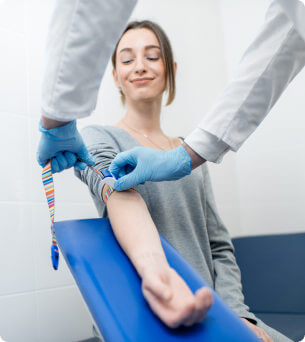Our laboratory cannot test without a sample or specimen. At Easly, you almost always have the option to take your sample or specimen at home. For self-collection, a small, almost painless finger prick is sufficient. Sometimes a bit of urine, mucus, or a skin or nail sample is needed, and you can also do this at home yourself. Some packages also offer venous collection by a healthcare worker. Below you’ll find everything about how to do a blood test at home and other different collection methods. Want to know more? Then read the instructions with our test kits or watch this video.
- Self-collection of blood with a finger prick
- Venous blood collection
- Collection of skin and nail samples
- Saliva sample collection
- Urine sample collection
- Feces collection
- STIs: vaginal and anal swab
- COVID-19 swab (antigen test)




Self-collection of blood with a finger prick
Often, a small blood sample is needed for Easly’s self-tests. For this purpose, the test kit includes needles, an EDTA and/or serum tube, alcohol swabs, patches, and gauze. Before taking the sample, first disinfect your finger with an alcohol swab. Then remove the cap from the lancet. Press the lancet against the side of your finger. The spring-loaded mechanism ensures that a very small hole is made in your finger, from which a small amount of blood wells up. You can collect the drops in the tube. The amount of blood needed may vary, and depends in part on the number of biomarkers being tested and the volume of the accompanying tube (an EDTA or serum tube). Seal the tube with the blood sample by pressing it shut, and place it in a safety bag, which you then send in the return envelope to the laboratory. Cover the spot where you pricked with a piece of gauze and the supplied plaster.
Venous blood collection
With venous blood collection, a doctor or a specialized and qualified healthcare worker takes blood directly from a vein with a needle, usually on the inside of the elbow. The puncture site is naturally disinfected first. After the puncture, the puncture hole will be covered with cotton wool and a plaster. It is important to press the puncture hole for thirty seconds to a minute to prevent a bruise. With venous collection, one or more tubes of blood are usually taken, which are processed in the laboratory. You can spare that blood perfectly, so you can go home or back to work afterwards. Easly only takes venous blood on location as part of one of the executive CEO health check packages.


Collection of skin and nail samples
A skin or nail sample is needed to determine the presence of fungi. A skin sample can be taken by scraping off some skin flakes with the scraper provided by Easly, where the skin is affected. The package also includes an alcohol swab, which is used to disinfect the collection site. The sample can be returned in the included derma package in the return envelope.
Scabies / Skin fungus
The nail sample is even easier to collect. With nail scissors, you cut off a piece of the affected nail. Then send the sample in the derma package in the return envelope to Easly. Also in the Fungal Nail self-test, an alcohol swab is included for disinfecting the test spot on the nail.
Collection of nail samples
Saliva sample collection
A saliva test is used, for example, to measure your cortisol level. Cortisol is a stress hormone that also plays an important role in the metabolism of the human body. Also in the self-test for intense athletes, some saliva must be taken. This is done by chewing on the provided sponge. The sponge goes into a tube and can be sent to Easly free of charge.
For the Corona PCR test, saliva must also be collected. This is done by spitting some saliva into the provided tube, during an online call, so that it can be determined that the sample really comes from you. The tube is sealed and sent to the laboratory, where the sample is processed. If you have had COVID-19 and no longer test positive, Easly will issue a recovery certificate.
Related tests



Urine sample collection
Urine samples are needed to test for STIs (only for men), diabetes, or kidney function. For the STI test, you urinate in a cup. With a pipette, you then draw up some urine from the cup. The contents of the pipette are then sprayed into the tube, which is sealed and placed in the safety bag, and can then be sent in the return envelope.
In the case of the Kidney Function self-test and the Diabetes self-test, urine collection is done slightly differently. In this case, a vacuum tube is used. After urinating in a cup, you hold the head (the white part) of the collection system in the urine. Then you attach the tube to the other side, and you prick the vacuum with it. The vacuum tube will then automatically fill up. You put the tube with urine in the safety bag and send it in the return envelope to the laboratory.
Feces collection
To determine the presence of bacteria and parasites – and thus the presence of infections – in the gastrointestinal tract, a bit of stool is needed. Therefore, Easly’s Complete Gastrointestinal Infections test kit includes a stool collector made of paper, with self-adhesive edges for easy attachment to the toilet. After depositing a small amount of stool, use the provided scoop to collect a sample in the collection pot. Seal the pot and send it to Easly’s laboratory for processing. The stool collector can be folded and safely flushed down the toilet. It’s best to wait before flushing to allow the paper to soften.
STIs: Vaginal and anal swab
An STI can be present in multiple parts of the body. For a swab, which you can perform at home, use a cotton swab to collect some mucus from your mouth, vagina, or anus. The exact location depends on the test being conducted and how you’ve had sex. In Easly’s self-tests, after collection, seal the entire cotton swab in a tube with a barcode on it. The process is a bit different for the vaginitis test: there, you only break off a portion of the cotton swab in the tube. Seal the tube, place it in the safety bag, and send it to the laboratory in the return envelope.
Vaginal swab
Anal
Oral
Vaginitis
Herpes/syfilis
COVID-19 swab (antigen test)
To determine if you have COVID-19, Easly’s antigen test uses a nasal swab. Insert a cotton swab into the nose and rotate it for ten seconds at the entrance to the nasal passage. Repeat this in the other nostril. Dip the tip of the cotton swab into the tube with buffer fluid. Rotate the cotton swab several times in the fluid while squeezing the bottom of the plastic tube. After half a minute, squeeze out three drops from the tube onto the cassette. After fifteen minutes, the cassette will have processed your sample. Take a photo of your test and discuss the result in an online call with Easly’s doctor. If the result is negative, you’ll receive a travel certificate, allowing you to board a plane with peace of mind.







